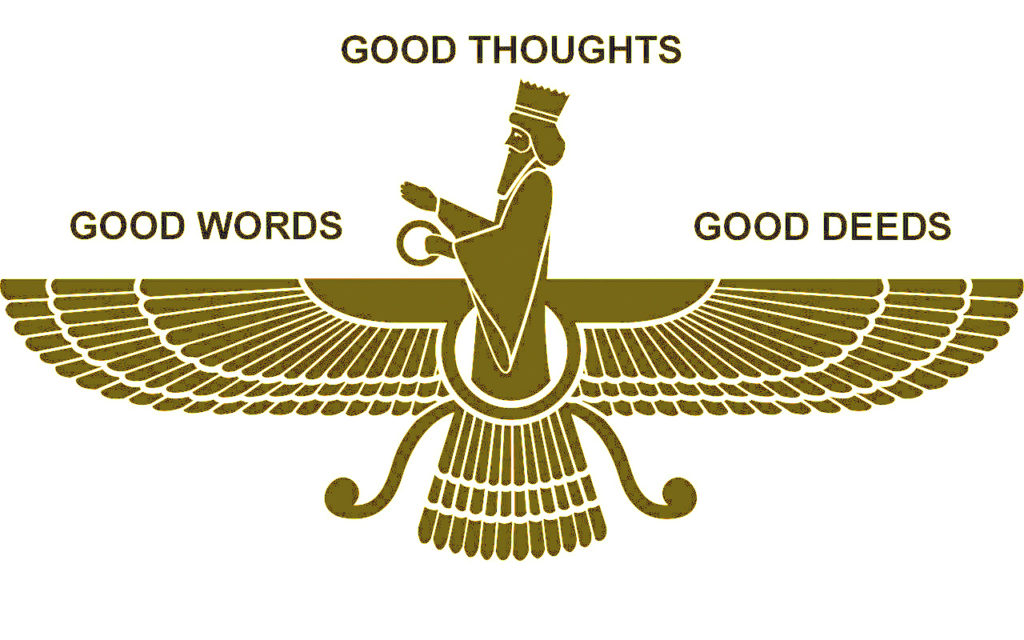
tat môi vîcidyâi vaocâ
hyat môi ashâ dâtâ vahyô
vîduyê vohû mananghâ
mêñcâ daidyâi ýehyâ-mâ ereshish
tâcît mazdâ ahurâ
ýâ nôit vâ anghat anghaitî vâ.
Speak to me so that I can discern
what has been made better with righteousness,
and know and realize through good mind
what has been granted to me as a seer.
Also, Wise Lord, the things
that will and will not happen.
The Doctrine of Renaissance of Zoroastrianism
The Doctrine of Renaissance of Zoroastrianism is based on three main pillars:
1. Evolutionary Development of the Mind.
2. Development of high morality, which includes helping people and protecting animals.
3. Increasing the amount of Inner Light and working with the Energy of Life.
Let’s examine the first point of the Doctrine of Renaissance of Zoroastrianism in more detail.
1. The Supermind exists.
This is a basic thesis, because if you are not able to realize the existence of the Supermind, then you are a priori unable to understand the Doctrine of Renaissance of Zoroastrianism.
2. The Supermind created the world that surrounds us.
3. The universe is built on the principle of a fractal. There is a basic structure that is repeated on a smaller scale.
4. From the fractal principle it follows that there is a hierarchy of Minds, starting with the Supermind that created the Universe and ending with the minimum level of development of Mind in the most primitive living organisms.
5. There is a Ladder of Evolutionary Development of Mind. On the first step of this ladder is the Mind that has a minimum level of development. At the top of this Ladder of Evolutionary Development of Mind is the Mind that created the Universe.
6. There is a Supermind, which for us is the Alpha Mind. This is the Mind that created life on the planet on which we live.
7. The Alpha Mind that created life on the planet is not yet the top of the Ladder of Evolutionary Development. In the hierarchy of Superminds, it occupies third place.
8. Between the Human Mind and the Alpha Mind there are three more steps of evolutionary development of Mind.
9. Compared to the level of development of the Alpha Mind, the level of development of the Human Mind is at a very low level.
10. Awareness of the fact that the level of development of your Mind is very, very low is the main criterion that initiates your desire for the Evolutionary Development of the Mind.
11. Due to the fact that a person has a very low level of development of the Mind, a lot of problems arise.
Let’s examine this point in more detail.
A. The limited development of the Human Mind does not allow him to understand the World that surrounds him.
B. The low level of development of the Human Mind does not allow him to create correct cause-and-effect relationships.
C. Failure to understand the reasons that motivate a person to commit certain actions forces a person to create false justifications for his actions. A person does not understand why he commits certain actions. Moreover, a person does not understand why other people commit certain actions. Therefore, the human Mind is forced to fill the “emptiness of misunderstanding” by creating fantasy interpretations that “explain” the reasons that motivate it to act.
D. A person lives his entire life creating fantasies about everything he encounters and comes into contact with.
E. The human Mind is forced to create a fantasy explanation for all the events that occur in his life, and this is done so that a person can survive.
F. If a person’s Mind is unable to create a fantasy explanation for the events that occurred in his life, which he, due to his low level of development, mistakenly verifies as “truth”, then a state of “unfinished action” arises, which generates neurosis, anxiety and depression.
G. From all of the above, it follows that the overwhelming majority of people do not strive to understand the Truth. The Mind of the overwhelming majority of people strives for a state of “illusion of stability”, and it is for this that the Mind of such people creates “fantasy interpretations/fantasy explanations” of the events that happened to them. And these fantasy explanations correspond to the level of development of the human Mind. And the lower the level of personal development of the Mind, the more primitive and the more absurd are the created “fantasy interpretations”.
12. The human Mind can evolve and become similar to the Alpha-Mind.
Through dedication to the ideals of the Renaissance of Zoroastrianism, the human mind has the potential to ascend to the sublime heights of Alpha Mind.
Let’s examine the second point of the Doctrine of Renaissance of Zoroastrianism in more detail.
1. Primacy of Good Thoughts, Words, and Deeds: The Zoroastrian ethical triad of Humata, Hukhta, Hvarshta (Good Thoughts, Good Words, Good Deeds) forms the cornerstone of moral life, urging individuals to align their intentions, speech, and actions with truth and righteousness.
2. Asha as the Foundation of Morality: The concept of Asha (truth, order, righteousness) is central to Zoroastrian ethics, guiding adherents to live in harmony with the divine order of the universe through honest and just behavior.
3. Free Will and Moral Responsibility: Zoroastrianism emphasizes human free will, teaching that individuals are morally accountable for their choices, which determine their spiritual destiny in this life and the afterlife.
4. Battle Against Evil: The dualistic struggle between Ahura Mazda (the Wise Lord, representing good) and Angra Mainyu (the destructive spirit, representing evil) underscores the moral duty to actively choose good over evil in thought and action.
5. Respect for All Creation: Zoroastrianism promotes stewardship of the environment, viewing the natural world—earth, water, fire, air—as sacred creations of Ahura Mazda, to be protected and revered.
6. Equality of All Souls: The religion teaches that all humans, regardless of gender, race, or social status, are equal in their capacity to pursue righteousness and attain salvation through ethical living.
7. Justice and Fairness in Society: Zoroastrian moral teachings advocate for social justice, encouraging adherents to uphold fairness, protect the vulnerable, and combat oppression in their communities.
8. Charity as a Moral Virtue: The practice of Khshathra Vairya (desirable dominion) emphasizes using power and resources to benefit others, exemplified through acts of charity and support for the needy.
9. Truthfulness as a Sacred Duty: Lying is considered a direct offense against Asha, and Zoroastrians are enjoined to speak the truth, fostering trust and integrity in personal and communal life.
10. Purity of Body and Soul: Ritual and ethical purity are intertwined, with practices like cleanliness and prayer reinforcing the moral discipline needed to resist evil influences.
11. Compassion and Benevolence: The principle of Vohu Manah (good mind) encourages compassion, kindness, and empathy toward others, fostering a community built on mutual care and respect.
12. The transition to the next stage of the Evolutionary Development of the Mind, formulated as “Accountability in the Afterlife”, a responsibility in the life following the exit from the biological body: the concept of the Chinvat Bridge, where souls/Ruvans are verified on the basis of their earthly deeds, reinforces the moral duty to live righteously, since actions have eternal consequences.
13. Promotion of Wisdom and Knowledge: Zoroastrianism values intellectual pursuit and wisdom (Spenta Mainyu, the creative spirit), encouraging adherents to seek understanding as a means to moral and spiritual growth.
14. Harmony in Community: The religion emphasizes Haurvatat (wholeness, community), promoting social cohesion through ethical interactions, mutual support, and collective responsibility for the common good.
15. Hope and Optimism in Moral Struggle: Zoroastrian eschatology envisions a final triumph of good over evil (Frashokereti), instilling hope and motivating adherents to persevere in moral efforts despite challenges.
Zoroastrianism is unique in that ethics and high morality are the basic part of the religious Doctrine. If in modern society ethics and morality exist outside the religious framework, then in Zoroastrianism ethics and morality are the basis of the religious Doctrine.
In Zoroastrianism, ethics and morality are considered only as an integral part of the Doctrine of Zoroastrianism.
High morality for the sake of morality itself. And the longer you go along the Path of moral perfection, the higher the level of moral requirements. For example, a priest of the Renaissance of Zoroastrianism cannot serve in the army even as a non-combatant. The higher a person climbs the ladder of moral perfection, the stricter the requirements he makes of himself.
I will tell in detail about the third point of the Doctrine of the Renaissance of Zoroastrianism to all those who join the Church “Alpha Mind” as the Temple of Renaissance of Zoroastrianism.
This Doctrine invites a journey of awakening, urging the Mind to transcend its limitations and align with the radiant truths of existence.
“To understand the world, develop your Mind – The Doctrine of Renaissance of Zoroastrianism offers a Way to overcome human limitations.”

Dr. Gen
Church Alpha Mind
